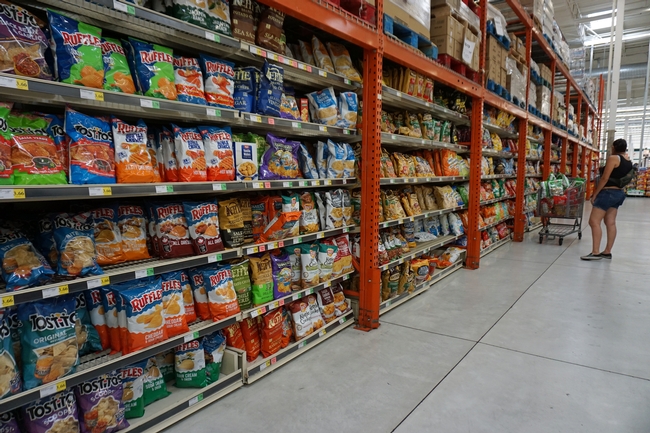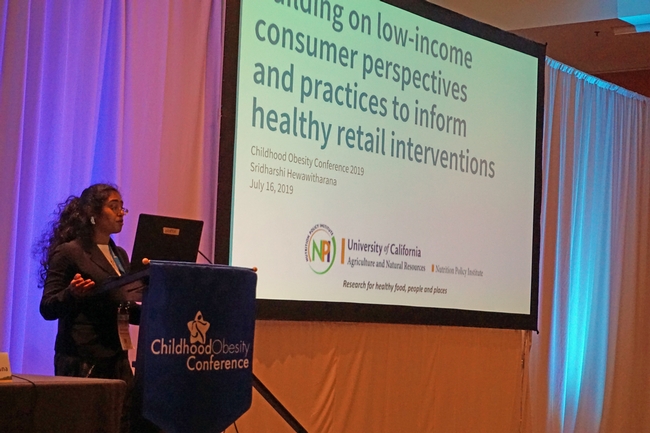In low-income communities, corner markets and convenience stores abound, but residents still buy most of their groceries at supermarkets. Unfortunately, larger grocery stores are also pushing shoppers in the direction of unhealthy food.

“Chips are near the salad. Chips are at the checkout. About 25 times during a shopping trip, sugary drinks nudge, prompt, poke and cajole you to buy,” Wootan said. “If healthy choices are not available, reasonably priced and attractively presented and promoted, people will have a hard time eating well.”
Sridharshi Hewawitharana, data analyst with the UC Nutrition Policy Institute, opened the retail session with the food shopping experiences of SNAP-eligible consumers, which they shared in focus groups. (SNAP is the federal Supplemental Nutrition Assistance Program, formerly called food stamps.) Hewawitharana also provided information from a survey of retail establishments and a literature review.
“SNAP participants want to eat healthfully, but report that it is too expensive,” she said.
For SNAP participants who want to shop in their own neighborhoods, price is a particularly high barrier. Prices of many produce items in convenience stores in low-income neighborhoods were more than double the county's average supermarket prices.
“It's so much more expensive if you want to get a good piece of fruit,” said a focus group participant. “I mean, this is California, a lot of them grow right here. We shouldn't have that issue buying fresh delicious fruit. But if you can't afford it, you do have issues.”
Participants said they used a variety of strategies to stretch their dollars and benefits, but often it still wasn't enough.
“When I get my food stamps, I try to stock up. Stock up on every meat, canned goods. Vegetables I know go bad within a couple of days, so I try to buy just for that week and save, but even at the end of the month, I'm out.”
Focus group participants also expressed stress and guilt for being unable to provide their children with an adequate amount of high quality food.
A team of NPI researchers conducted the healthy retail literature review. Hewawitharana said they identified promising ways to help SNAP participants make heathy choices when food shopping. Surprisingly, opening new supermarkets was found to be ineffective. Addressing food prices is the most effective strategy. Taxing unhealthy food discourages these purchases. Reducing the price of healthy foods by offering coupons or vouchers is the best way to motivate healthy supermarket choices.
“The low income populations are really struggling,” Hewawitharana said. “High housing costs in California makes it more difficult. This is causing them emotional and mental stress.”
Wootan suggested changing grocery store layouts and promotions to make the healthy choice the easy choice. Currently, food vendors – many who sell processed foods high in sugar, salt and fat – pay grocery stores for prime locations, including eye-level shelves and end caps.
“Grocery stores earn a lot of revenue by giving large food companies preferential treatment,” said Gail Woodward-Lopez, associate director of research at the UC Nutrition Policy Institute, who moderated the session. “A really big company can go in with a loss, but a small, local manufacturer cannot.”
The current condition of America's supermarkets leaves room for public health, consumer advocacy and government agencies to make substantive impacts.
“We need research,” Wootan said. “What does a profitable, healthy grocery store look like?”
As for implementing changes, other obstacles await.
“I don't think voluntary (changes) will work. We are working on policy,” Wootan said.
Some stores are taking voluntary measures to make the shopping experience healthier. Yvette Waters, nutrition strategist at Raley's supermarkets, also spoke at the conference.
The store offers free fruit for children in the produce section and stocks no sodas in the checkout stands. In the cereal section, Raley's has changed the layout, giving prime shelf space to products with less sugar. Cereals with 25% or more of total calories from sugar are now on the bottom shelf.
“And we aren't stopping at the cereal aisle,” Waters said.
